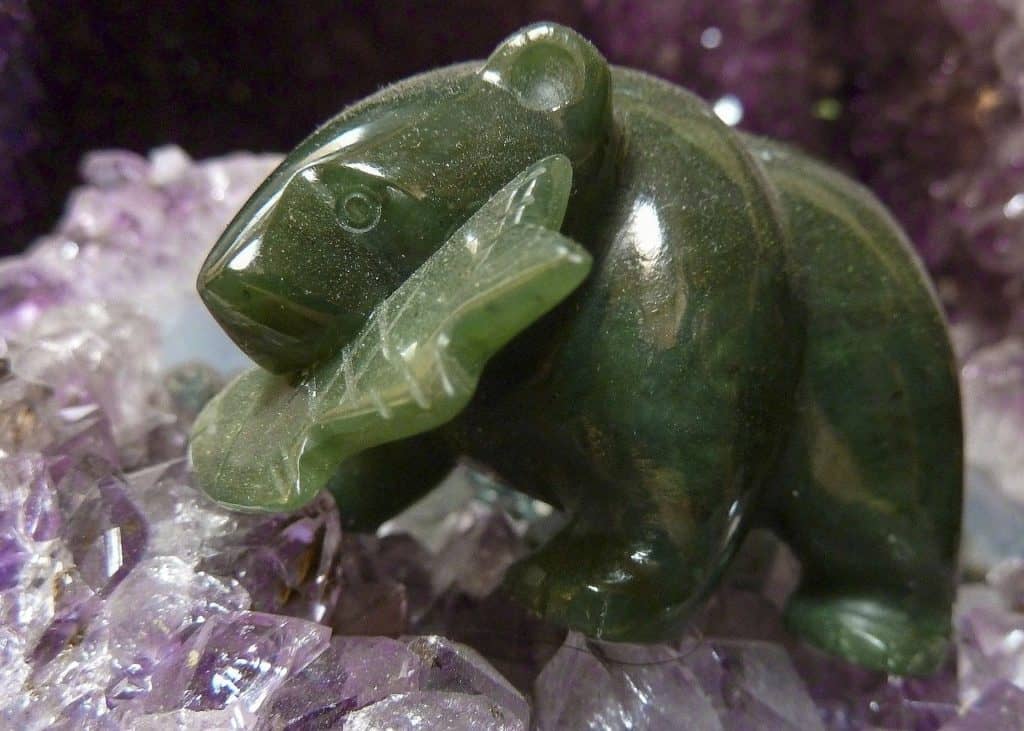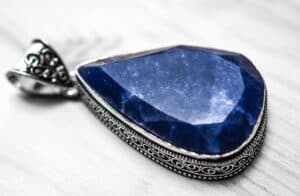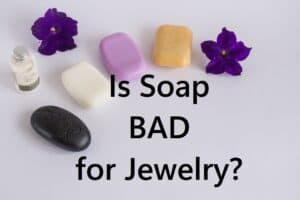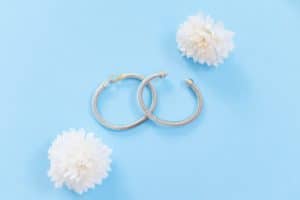Jade refers to two distinct gem materials- jadeite and nephrite. Both are metamorphic rocks composed of small interlocking mineral crystals. Jadeite is available in various appealing colors- shades of green, yellow, and reddish-orange, white, grey, black, brown, and lavender (often a light purple or light greyish violet color).
In the worldwide gem and jewelry market, nephrite is also known as Jade. It can be bright to dark green, yellow, brown, black, grey, or white and varies from transparent to opaque. Nephrite is a magnesium-rich amphibole, whereas jadeite is aluminum-rich pyroxene. However, in the eyes of the typical person, the two minerals exhibit extremely similar physical characteristics.
Hardness & Strength
Is real jade harder than diamonds?
The hardness of jade on Moh’s scale is between 6 and 7 and the of diamond is 10. Therefore, real jade is not harder than diamonds.
However, out of the 2 varieties, Jadeite is harder than Nephrite. Having said that, a stronger intermolecular structure of Nephrite makes it more difficult to break.
Is jade stronger than diamond and steel?
Jade is definitely stronger than steel. While jade hardness of ranges between 6-7, hardness of normal steel is between 4-4.5.
However, jade is not as hard as diamond like we just mentioned!
However, the hardness of 7 makes jades really durable. “Jade” is a cultural word for a durable gemstone that has been utilized for over 5,000 years to create tools, sculptures, jewelry, gemstones, and other items. Because of its hardness, it was initially used to make axe heads, weapons, and scraping and hammering implements. Now, they are used to make jewelry.
Will jade break if dropped?
Untreated Jade is unlikely to break. However, processed Jade may break under certain conditions.
- If it is dehydrated: Processing the stone and subjecting it to heat causes jade to dehydrate. A dehydrated jade will brake more easily in comparison to a well hydrated one.
- If it is over treated: The treatments harm and weaken the surface. This may cause the stone to become more brittle.
- Type of jade: When dropped on a tile floor, Jade can break if it is a Jadeite. This is because it is more brittle when compared to Nephrite because Nephrite has a stronger inter molecular structure. At the same time, Jadeite is normally harder and more durable
Since Jade is the least brittle stone, it may be carved into delicate and complex pieces, as well as strong bangles, without danger of breaking at the slightest touch.
Visual properties

Does real jade glow in the dark?
While real jadeite does not glow in the dark, a piece of Jade that is translucent and bright might seem to ‘glow’. However, a magic cup or luminous cup made of Jade shines brightly in the night
In actuality, bright cups are constructed of beautifully carved Jade or agate mined from Mt. Qilian, rich in natural elements. Some may be perplexed by the jade cups’ apparent black look and wonder about their alleged brightness at first glance.
The glowing cup had a tradition of offering homage to the Chinese rulers during the Western Zhou Dynasty. Luminous cups made of Hetian jade were sent to Chang’an, Luoyang, and other cities. Because the jade cup easily broke during transit, the Hetian jade was later taken to Jiuquan and transformed into a bright cup before being delivered.
When Hetian jade became scarce, Jiuquan jade mined in the Qilian Mountains was utilized to manufacture brilliant cups.
The cup’s mesmerizing brilliance and translucency unveil themselves when filled with drink and viewed under artificial light or moonlight. The liquid within well-made cups frequently exhibits the distinctive, enticing shimmer.
Does real jade change colour over time?
Yes, real jade may change color over time and become browner, deeper in color. Jade is polycrystalline, which means it is composed of interconnected crystals. It is permeable as a result of its physical characteristics. When Jade is worn for an extended length of time, it absorbs your body oil, liquids, filth, and so on. This makes it change it’s color.
Green Jade
Jadeite jade is commonly treated to improve its color since “green” jadeite is considered more precious than other colors. It is accomplished by the use of bleaching, dying, and polymer – impregnation. This kind of Jade is known as B+C Jade. Jadeite Jade (also known as hard Jade or valuable Jade) is a microcrystalline rock that faces discoloration with time.
Yellow Jade
This natural discoloration is observed in Yellow Jade. Although the original jade rock may have been white, surrounding soil with a high iron concentration might cause the stone to become yellow.
Does real jade fade over time?
Jade gemstones that occur naturally do not fade, but inferior stones that have been processed to seem like high-quality Jade can fade over time. Bleached stained jade gemstones are colored after being injected with a type of plastic. This procedure is invisible to the naked eye, although the colors used will fade with time.
Because the jade treatment method is complicated, the spectrographic examination is necessary to properly identify jade treatment. Vendors are obligated to tell consumers when they discover a gemstone has been treated, but purchasers should also inquire.
Let us also look at different types of jade and their physical properties.
| Variant | Hardness and Strength | Physical Properties | Feel | Price per Carat |
|---|---|---|---|---|
| Type A | Excellent as it is hardest of the 3 | Natural, unprocessed, goes through a traditional procedure (plum juice washing and beeswax polishing), no artificial treatments (e.g., high temperature or high-pressure treatments), real color. | Feels colder than room temperature | $250 |
| Type B | Good | Chemically bleached to remove impurities, injected with polymer using a centrifuge to increase translucency, covered with a hard and clear plastic-like coating, subject to instability and discoloration over time due to heat or household detergent, but still 100% real jade with 100% natural color. | Feels colder than room temperature | $150 |
| Type C | Good | Chemically bleached, colored and susceptible to deterioration over time as a result of interaction with intense light, body heat, or household detergent. | Feels colder than room temperature | $100 |
Feel

What does real jade feel like?
Real Jade is smooth and soapy to the touch, and its temperature is lower than the room’s temperature. It should stay chilly in your palm for some time if it is a real jade. If it is already heated or becomes warm quickly after being held, it may be a fake jade.
Genuine stones are more likely to exhibit minute flaws such as an irregular form, surface dips, or pitting. Genuine stones will also show color gradation over the surface, but this would appear like a pattern throughout the stone. These may persist after the stone has been polished. When compared to stones of the same size and form, real Jade is a thick stone that feels heavy in your hands.
- Check to see whether it feels cold on your skin by pressing it against your face or neck.
- Wrap your hand around the stone and place it in your palm.
- Squeeze the stone tightly in an attempt to heat it up.
- Wait for 1-2 minutes, then check to see whether the stone is still cool. Genuine Jade should remain cold to the touch.
Does real jade feel cold?
Yes, real jade will always feel cold against your skin. Even if you hold it for a while, you will still find that the stone is still cold.
If you feel it has warmed up a bit on wearing or holding for too long, just keep it away for about 30 seconds and touch it again, if it feels cold again, it is real jade.
How do you tell if jade is of good quality?
The quality of Jade is assessed by its color, transparency, texture, and cut. The weight and size of a jade stone must also be taken into account when assessing its worth.
- Color: The color of Jade contributes to its excellence. Jade is available in lavender, red, and black, but green Jade is the most precious and of the highest quality. Imperial Jade, a bright green that borders on transparency, and kingfisher jade, a less intense green, are two examples.
- Transparency: Transparency is essential for jade quality. The best Jade is semi-transparent, giving the appearance of fuzzy things when viewed through it. Customers may find it more appealing if the light coming from beneath the surface of such Jade appears to shine. In terms of value, greater transparency is more essential than color consistency.
- Texture: Texture may also be used to assess the worth of Jade. However, this value is dependent on the use of the Jade. While decorative Jade is generally smoother, ancient jade weaponry depended on rough Jade that would not readily break.
- Cut: The cut of Jade is critical to its quality. While Jade may be cut in a variety of ways, the best grade jade is cut into the shape of cabochons to match rings and other jewelry. High-quality Jade may also be shaped into spherical beads and strung together to form a bigger thread.
Conclusion
Diamonds, rubies, sapphires, emeralds, opals, garnets, and a few other stones are far more popular in the United States and Europe than Jade. In these areas, Jade is not regarded to be as valuable as it is in China.
Now that you know everything about the magnificent jade gemstone, it is simple to see why this stone is so popular. On the surface, Jade may appear to be simply another lovely green stone. However, behind the surface, Jade is full of light and love that has touched hearts for ages. Moreover, Jade reminds you that no matter what imperfections you perceive in yourself, you still have light to share with the world.




